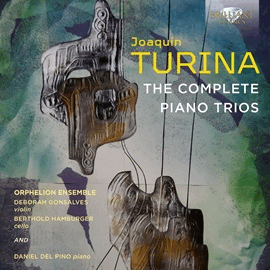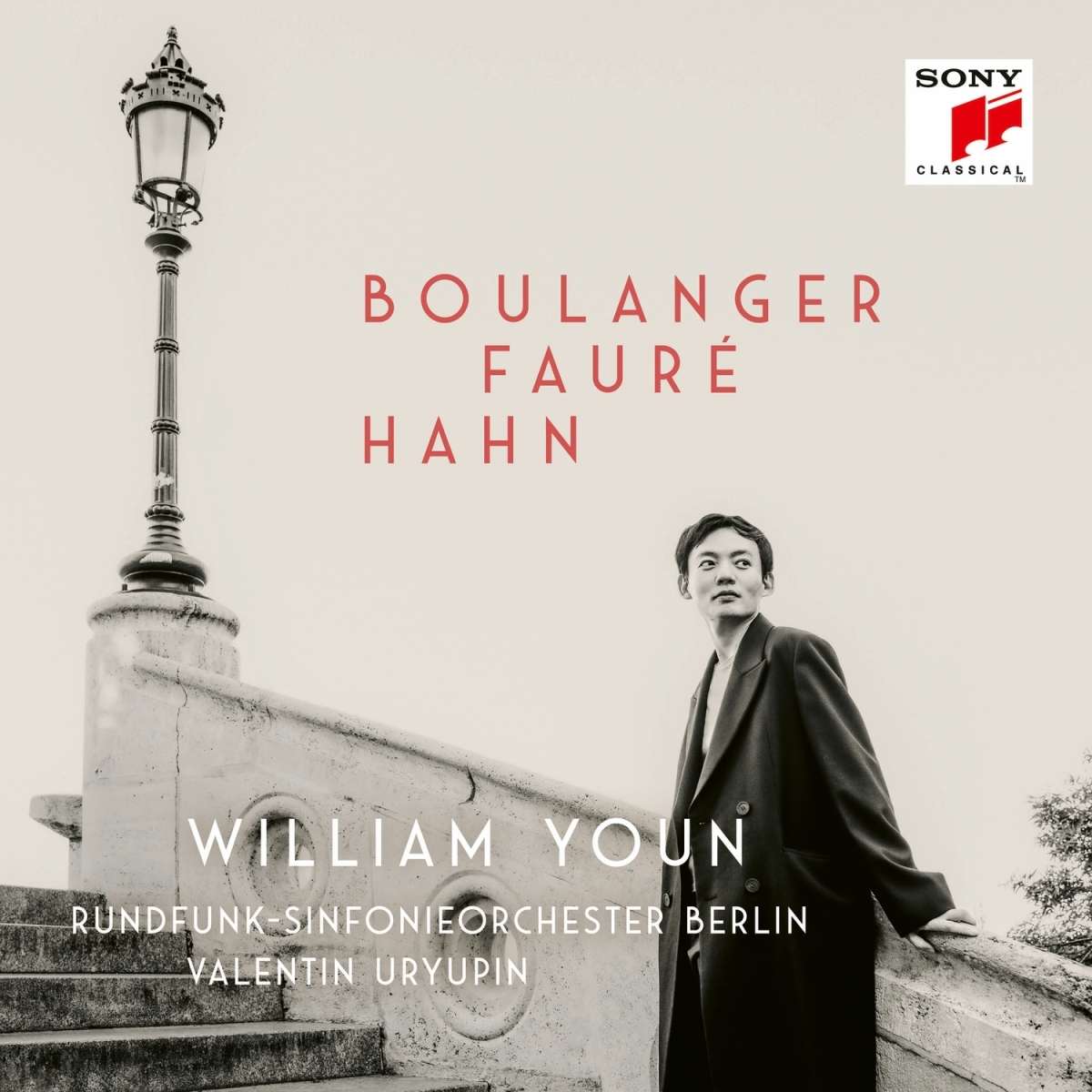Das Klavierkonzert von Reynaldo Hahn ist das längste Stück auf diesem Album. Es wurde am 4. Februar 1931 im Théâtre des Champs-Elysées in Paris von der brasilianischen Pianistin Magda Tagliaferro uraufgeführt, mit dem Komponisten am Dirigentenpult des Orchestre Symphonique de Paris.
Den ersten, fantasievoll frei gefügten Satz hat der Komponist mit ‘Improvisation: Modéré très librement’ überschrieben. Darauf folgt ein hier sehr verspielt aufgeführtes Leichtes Rondo und schließlich das kontrastreiche Rêverie, Toccata et Finale (Träumerei, Toccata und Finale) . Die Interpretation ist von großem Raffinement und sehr stimmungsvoll dazu. Das Elegant-Französische, das Intime und Verträumte kontrastiert ideal mit den virtuoseren Passagen. So kommt Hahns Einfallsreichtum, vor allem im geistreichen Finale, ebenso zum Ausdruck wie seine Ausdruckskraft. So idiomatisch klingt keine der mir bekannten Aufnahme dieses Konzerts, abgesehen von jener mit Tagliaferro und Hahn. Die aber kann klanglich nicht mithalten.
Hahns Herz schlug bekanntlich vor allem für die Vokalmusik, komponierte er doch sechs Opern, acht Operetten, viele andere Vokalwerke sowie eine Vielzahl an Liedern. Zwei davon, À Chloris und L’heure exquise, hat William Youn selbst für Klavier solo bearbeitet und dieser Aufnahme hinzugefügt. Sie sind, genau wie die Bearbeitung von Faurés Lied Après un rêve, von bewegend lyrischer Poesie.
Die Ballade op. 19 von Gabriel Fauré ist sein erstes bedeutendes Werk für Klavier solo. Es wurde 1879 komponiert und ist seinem Lehrer Camille Saint-Saëns gewidmet. Fauré fertigte davon später eine Version mit Orchester an, die auf diesem Album erklingt. William Youn und das RSB spielen feinfühlig und betonen Faurés Eigenart im Gegensatz zu jenen Interpretationen, die versuchen, den Franzosen in die Nähe von Chopin zu rücken. Hier wird Fauré in ein neues Licht, gestellt, mit viel Poesie und Kantabilität.
Nadia Boulangers Fantasie beginnt mit einer düsteren Orchestereinleitung, ehe das Klavier ein Thema entwickelt, das « aus einem russischen Volkslied konstruiert » ist. Danach folgen drei Passagen in Form von virtuosen rhapsodischen Variationen. Der Kritiker des Figaro sprach zwar in seiner Kritik nach der Uraufführung von einer ganz männlichen Kraft, aber Nadia Boulanger hatte die Fantasie für den Pianisten Raoul Pugno komponiert, mit dem sie liiert war und den sie nicht nur verehrte, sondern auch liebte. Das würde dann die mit sehr leidenschaftlichen Passagen kontrastierenden sehr zarten Momente erklären, die es in der Fantasie gibt, und die William Youn mit wunderbarer poetischer Ausdruckskraft spielt.
Gabriel Faurés Fantaisie op. 111 entstand 1918 und ist dem Pianisten Alfred Cortot gewidmet, der sie aber letztlich, wie er schrieb, wegen fehlender Brillanz und mangelnder Kontraste zwischen dem Klavier und dem Orchester nicht wirklich mochte. William Youns Gespür für die Subtilität und Eleganz dieser Musik lässt seine sehr natürlich klingende, geschmeidige und fein fließende Interpretation zu einer der besten werden, die auf Tonträgern zur Verfügung stehen.
Und so ist dies denn, aufs Ganze gesehen, eine herausragende Produktion, in der ein koreanischer Pianist, ein ukrainischer Dirigent und ein deutsches Orchester sich die französische Musik völlig zu eigen machen. Hinzu kommt die Attraktivität der intelligenten und harmonischen Programmgestaltung, die zu den originellsten zahlt di man in diesem Repertoire finden kann.
The piano concerto by Reynaldo Hahn is the longest piece on this album. It was premiered on February 4, 1931 at the Théâtre des Champs-Elysées in Paris by the Brazilian pianist Magda Tagliaferro, with the composer conducting the Orchestre Symphonique de Paris.
The composer entitled the first, imaginatively free movement ‘Improvisation: Modéré très librement’. This is followed by a very playful Light Rondo and finally the contrasting Rêverie, Toccata et Finale. The interpretation is highly refined and very atmospheric. The elegant French, intimate and dreamy character contrasts ideally with the more virtuosic passages. Hahn’s ingenuity, especially in the witty finale, is just as expressive as his expressive power. None of the recordings of this concerto that I know of sound so idiomatic, apart from the one with Tagliaferro and Hahn. But it cannot keep up in terms of sound.
As is well known, Hahn’s heart beat above all for vocal music, as he composed six operas, eight operettas, many other vocal works and a large number of songs. Two of these, À Chloris and L’heure exquise, were arranged for solo piano by William Youn himself and added to this recording. Like the arrangement of Fauré’s song Après un rêve, they are movingly lyrical and poetic.
The Ballade op. 19 by Gabriel Fauré is his first important work for solo piano. It was composed in 1879 and is dedicated to his teacher Camille Saint-Saëns. Fauré later produced a version with orchestra, which can be heard on this album. William Youn and the RSB play sensitively and emphasize Fauré’s individuality in contrast to those interpretations that attempt to place the French composer in the vicinity of Chopin. Here, Fauré is presented in a new light, with a great deal of poetry and cantabile.
Nadia Boulanger’s Fantasy begins with a somber orchestral introduction before the piano develops a theme « constructed from a Russian folk song ». This is followed by three passages in the form of virtuoso rhapsodic variations. In his review after the premiere, the critic of Figaro spoke of an entirely masculine force, but Nadia Boulanger had composed the fantasy for the pianist Raoul Pugno, with whom she was in a relationship and whom she not only admired but also loved. This would explain the very tender moments in the fantasy, which contrast with very passionate passages and which William Youn plays with wonderful poetic expressiveness.
Gabriel Fauré’s Fantaisie op. 111 was composed in 1918 and is dedicated to the pianist Alfred Cortot, who, as he wrote, ultimately did not really like it because of its lack of brilliance and the lack of contrasts between the piano and the orchestra. William Youn’s feel for the subtlety and elegance of this music makes his very natural-sounding, smooth and finely flowing interpretation one of the best available on record.
And so, on the whole, this is an outstanding production in which a Korean pianist, a Ukrainian conductor and a German orchestra make the French music completely their own. Added to this is the attractiveness of the intelligent and harmonious program design, which is one of the most original to be found in this repertoire.


















